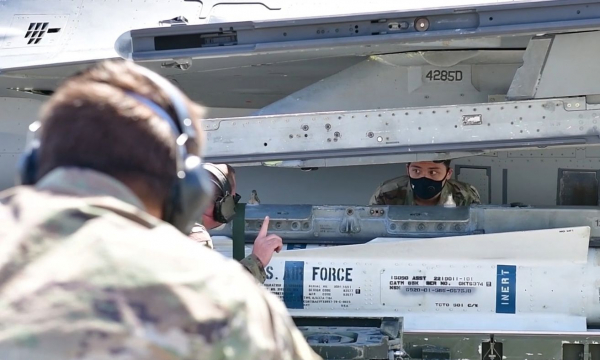However, as the virus spread through the region, Aviano’s Airmen and aircraft have been able to fly as much as normal, if not more, through a realignment of their training priorities, increased social distancing, and finding new ways to be flexible.
“Projecting combat airpower is our primary mission, and that is a way we’re going to contribute to beating this virus,” said Capt. Claire Bieber, an F-16 pilot with Aviano’s 510th Fighter Squadron. “I know that sounds like it’s not correlated, but it is important to make sure that both Americans and everybody else knows that this isn’t going to beat us and that we’re going to continue to be ready, no matter what hazard or threat is thrown our way.
“We’re working really, really hard to minimize the risk and minimize the exposure. We’re taking really, really careful precautions to ensure the safety of all of our members and their families. But it can’t be understated how important it is that we’re still projecting airpower,” Bieber said.
The base hosts two rescue squadrons and two F-16 squadrons. The 510th is at the base, flying often, while its sister squadron, the 555th “Triple Nickel,” is still in the Middle East on a combat deployment that will be extended as part of the Defense Department’s stop movement order in response to the pandemic.
For the 510th back home, this means more space to work and more time to fly. Before COVID-19 changed how the broader military operates, the fighter squadron’s biggest focus was on Agile Combat Employment—deploying jets and personnel to operate at a separate, remote location. But since forward deploying isn’t possible and partner nations aren’t flying as often, the 510th has gone back to basics and focused on its local training.
“We’ve kind of changed our turn pattern around pretty significantly, but [we’re] still flying as much as we were before, and maybe a little more, and continuing to press with our phased-based training like we normally would,” Bieber said.
Additionally, the squadron has changed its flying schedule so the same pilots and maintainers work on a jet for the day instead of rotating through. This means pilots can fly two to three times per day, and those who are off can stay home to telework and help their families in isolation. Before COVID-19, regular operations meant about 12 F-16 flights each morning and 10 in the afternoon. Now, the schedule is typically eight sorties in the morning, eight in the afternoon, and eight overnight. Pilots used to have 10 to 15 fly days per month. Now it’s just four or five, but those include three sorties per day.
“So you’re still getting basically the same amount of flying in, but it’s just kind of all in one day,” Bieber said. “So that makes for some pretty long debriefs,” which are done remotely.
The base has medical staff embedded in the squadron, with daily check-ins, and Airmen are encouraged to stay home if they are feeling sick. Plus, “there’s hand sanitizer literally all over the place.”
Aviano’s rescue squadrons, the 56th and 57th, have only been at the Italian base since late 2018 and teams have recently returned from a deployment. Like the fighter squadron, the HH-60s and pararescue crews are also limited in how they can train, because they are largely restricted to the base.
Before the lockdown, the 56th was able to integrate regularly with NATO countries and fly in places such as Croatia and Slovenia. Now the aircraft are still flying at full capacity, but locally in the mountain areas around the base and over the Adriatic Sea, said Capt. Samuel McNell, a pilot with the 56th RQS.
This training has included recent jumps from the helicopters on base for the pararescumen, “so we’re still maintaining combat mission readiness,” said Capt. Jordan Nichols, a combat rescue officer with the 57th Rescue Squadron.
There is a shortfall of live fire training scenarios, but special mission aviators still fly with pilots and “get what we can with what’s available” in those mountain and over-water flights, said Master Sgt. Douglas Souza, a special missions aviator and operations superintendent with the 56th RQS.
“So it’s definitely been choppy, we’re maintaining our combat mission ready status,” Souza said. “It’s just different.”
Outside of those events, Airmen have moved online, like much of the rest of the world. Airmen who can work from home are conducting meetings through platforms like Zoom, while others are still going to the base for training.
“We found ways to adapt and overcome, essentially taking more of an academic outlook on this,” Nichols said.
The region around Aviano is among the hardest-hit locations in the world, with more than 147,000 confirmed cases as of April 10. The situation became real for Airmen at the base with the Defense Department’s stop movement order in mid-March, and increasing lockdown orders from the Italian government.
Aviano Airmen not living in dorms live in the surrounding area off base, and have had to receive special permission and documents to be able to travel to work. While many Airmen have been able to increase their remote work, others such as finance, communications, post office, security forces, etc., “Those guys are unbelievable right now. … They’re still up and running. Nobody’s stopped,” Souza said.
Some Airmen expecting to go through their permanent change of station to leave the base have remained, while those who have recently arrived are unable to do things like find a house, so they are living in temporary lodging. Schools are closed, so children need to be homeschooled and spouses can’t work or leave the house when Airmen need to report to work.
Those off base can’t even leave the house for a run or walk outside of their immediate location as the Italian government decrees have grown in intensity.
“It’s definitely challenging for people, which is why it’s really nice to be able to lean on our squadron,” Bieber said. “I know in the 510th we have a really close-knit, family-type environment. And we’ve got all these different chats.”
In the 57th, “We just miss each other. Especially since we are segregated. From the very start, when PJs start going through the pipeline, everything’s very team oriented. So now you’re broken out into a smaller team, so you don’t get to see your best friends every single day. It does help out having WhatsApp chats, having Zoom meeting so guys can razz each other. But we definitely, definitely just miss each other. That’s for sure,” Nichols said.
“Pretty much everyone’s dealing with the challenges, but really the only thing you can control is your attitude and that’s kind of what we’re trying to go with for our squadron. Things are gonna change, but we just have to have a good attitude, regardless of the situation, to continue to train and to continue to be ready.”

